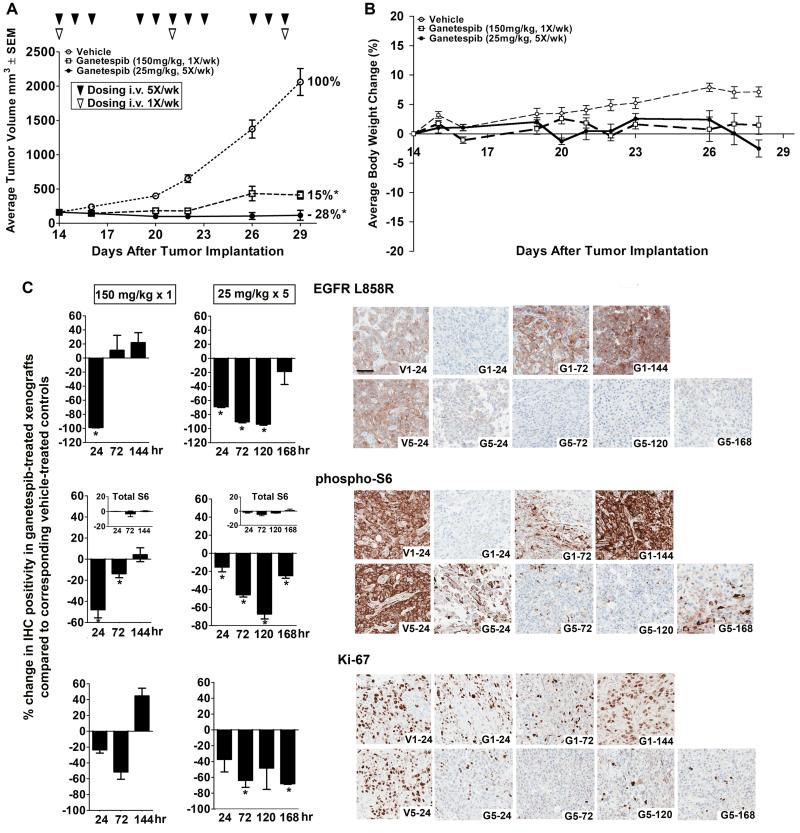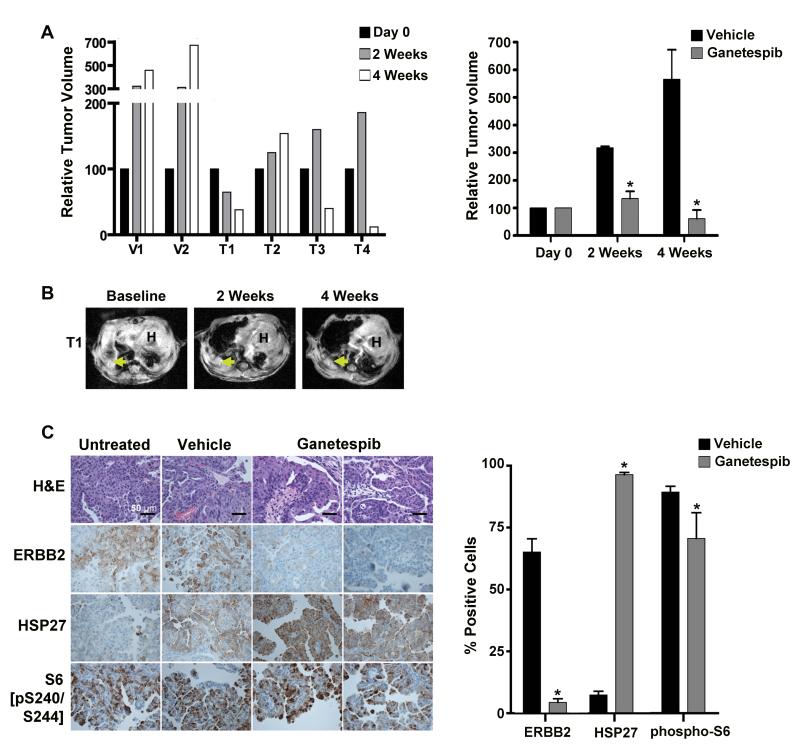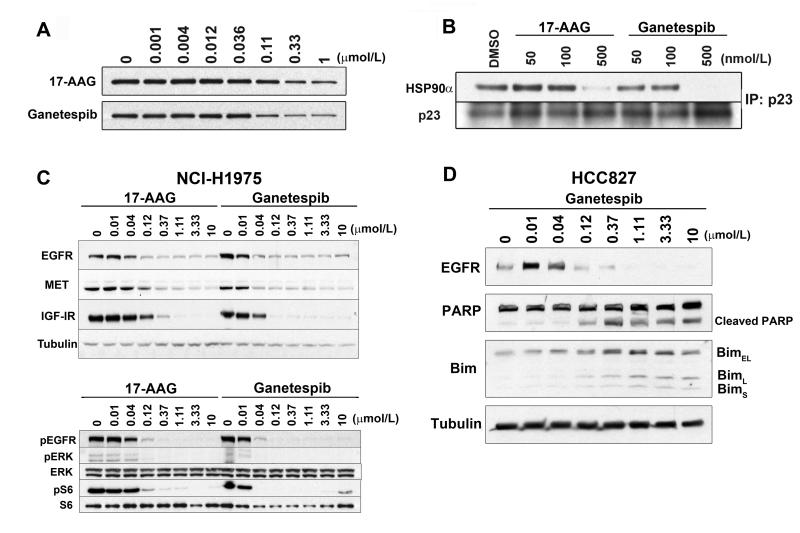
| Size | Price | Stock | Qty |
|---|---|---|---|
| 10mg |
|
||
| 25mg |
|
||
| 50mg |
|
||
| 100mg |
|
||
| 250mg |
|
||
| 500mg |
|
||
| 1g |
|
||
| Other Sizes |
|
Purity: ≥98%
Ganetespib (formerly STA-9090; STA 9090; STA9090), the active metabolite of STA-1474 (a prodrug of ganetespib), is a potent and triazolone-based small-molecule HSP90 (heat shock protein 90) inhibitor with potential anticancer activity. It inhibits HSP90 with an IC50 of 4 nM in OSA 8 cells, and induces apoptosis of OSA cells while normal osteoblasts are not affected. Ganetespib is being investigated for the treatment of various cancers such as Small Cell Lung Cancer, breast cancer, Acute Myeloid Leukaemia, and Myelodysplastic Syndrome.
| Targets |
HSP90
|
||
|---|---|---|---|
| ln Vitro |
In genomically characterized NSCLC cell lines, genesetib induces apoptosis, suppresses downstream signaling, depletes receptor tyrosine kinases, and inhibits proliferation with IC50 values ranging from 2 to 30 nM. Additionally, in isogenic Ba/F3 pro-B cells that have been made IL-3 independent through the production of EGFR and ERBB2 mutants, genetecib is around 20 times more potent[1]. In vitro, genetecib is more effective than 17-allylamino-17-demethoxygeldanamycin (17-AAG), an ansamycin inhibitor, at causing the degradation of known Hsp90 client proteins. It also shows strong cytotoxicity in a variety of solid and hematologic tumor cell lines[2]. Strong HSP90 inhibitor genesetespib has been demonstrated to destroy canine tumor cell lines in vitro[3]. In the HEL92.1.7 cells, genesetib exhibits more potent or prolonged JAK/STAT inhibitory activity compared to P6 and 17-AAG[4].
|
||
| ln Vivo |
In NCI-H1975 xenografts, genetecib (125 mg/kg, IV) accumulates in tumors more than in normal tissues and has higher in vivo efficacy than 17-AAG without causing additional toxicity. It also slows proliferation and promotes apoptosis together with EGFR depletion[1]. (100, 125, 150 mg/kg, iv) significantly inhibits development and/or reverses tumor growth in solid and hematologic xenograft models of oncogene addiction, demonstrating strong anticancer efficacy[2].
|
||
| Enzyme Assay |
HSP90 binding assays[1]
Exponentially growing cells were processed in lysis buffer (20 mM HEPES, pH 7.4, 1 mM EDTA, 5 mM MgCl2, 100 mM KCl) and incubated with increasing concentrations of 17-AAG or ganetespib for 30 min at 4°C, and incubated with biotin-GM linked to Dynabeads MyOne Streptavidin T1 magnetic bead for 1 h at 4°C. Beads were washed three times in lysis buffer and heated for 5 min at 95°C in SDS–PAGE sample buffer (Invitrogen). Samples were resolved on 4-12% Bis-Tris gradient gel and Western blots were performed using an anti-HSP90 antibody. |
||
| Cell Assay |
Cell proliferation assay[1]
Cell proliferation assays were performed using the CCK-8 colorimetric assay in at least duplicate samples according to the manufacturer’s specifications. IC50 values were calculated using Kaleidagraph or Graphpad Prism. Western blots[1] Whole-cell lysates were prepared as previously described (9). Protein concentrations were determined and equivalent amounts (20 μg) were subjected to SDS-PAGE on 4-12% bis-tris gradient gels (Invitrogen). The HSP27 antibody was from Enzo Life Sciences. p23 and HSP90αantibodies were from StressMarq. Immunoprecipitation[1] 500 μg of whole cell lysate was immunoprecipitated with 2 μg of mouse anti-p23 monoclonal antibody conjugated with protein A Dynabeads. Proteins bound to p23 were resolved on 4-12% bis-tris gradient gels and Western blot was performed with an anti-HSP90 antibody. |
||
| Animal Protocol |
|
||
| References |
|
||
| Additional Infomation |
Ganetespib is a member of triazoles and a ring assembly.
Ganetespib is under investigation for the treatment of BREAST CANCER, Small Cell Lung Cancer, Acute Myeloid Leukaemia, and Myelodysplastic Syndrome. Ganetespib is a synthetic small-molecule inhibitor of heat shock protein 90 (Hsp90) with potential antineoplastic activity. Ganetespib binds to and inhibits Hsp90, resulting in the proteasomal degradation of oncogenic client proteins, the inhibition of cell proliferation and the elevation of heat shock protein 72 (Hsp72); it may inhibit the activity of multiple kinases, such as c-Kit, EGFR, and Bcr-Abl, which as client proteins depend on functional HsP90 for maintenance. Hsp90, a 90 kDa molecular chaperone upregulated in a variety of tumor cells, plays a key role in the conformational maturation, stability and function of "client" proteins within the cell, many of which are involved in signal transduction, cell cycle regulation and apoptosis, including kinases, transcription factors and hormone receptors. Hsp72 exhibits anti-apoptotic functions; its up-regulation may be used as a surrogate marker for Hsp90 inhibition. |
| Molecular Formula |
C20H20N4O3
|
|
|---|---|---|
| Molecular Weight |
364.4
|
|
| Exact Mass |
364.153
|
|
| Elemental Analysis |
C, 65.92; H, 5.53; N, 15.38; O, 13.17
|
|
| CAS # |
888216-25-9
|
|
| Related CAS # |
|
|
| PubChem CID |
135564985
|
|
| Appearance |
White to yellow solid powder
|
|
| Density |
1.4±0.1 g/cm3
|
|
| Boiling Point |
685.8±57.0 °C at 760 mmHg
|
|
| Flash Point |
368.5±32.1 °C
|
|
| Vapour Pressure |
0.0±2.2 mmHg at 25°C
|
|
| Index of Refraction |
1.698
|
|
| LogP |
5.47
|
|
| Hydrogen Bond Donor Count |
3
|
|
| Hydrogen Bond Acceptor Count |
4
|
|
| Rotatable Bond Count |
3
|
|
| Heavy Atom Count |
27
|
|
| Complexity |
610
|
|
| Defined Atom Stereocenter Count |
0
|
|
| InChi Key |
RVAQIUULWULRNW-UHFFFAOYSA-N
|
|
| InChi Code |
InChI=1S/C20H20N4O3/c1-11(2)14-9-15(18(26)10-17(14)25)19-21-22-20(27)24(19)13-4-5-16-12(8-13)6-7-23(16)3/h4-11,25-26H,1-3H3,(H,22,27)
|
|
| Chemical Name |
5-[2,4-dihydroxy-5-(1-methylethyl)phenyl]-4-(1-methyl-1H-indol-5-yl)-2,4-dihydro-3H- 1,2,4-triazol-3-one
|
|
| Synonyms |
STA-9090; Ganetespib; STA 9090; STA9090
|
|
| HS Tariff Code |
2934.99.9001
|
|
| Storage |
Powder -20°C 3 years 4°C 2 years In solvent -80°C 6 months -20°C 1 month |
|
| Shipping Condition |
Room temperature (This product is stable at ambient temperature for a few days during ordinary shipping and time spent in Customs)
|
| Solubility (In Vitro) |
|
|||
|---|---|---|---|---|
| Solubility (In Vivo) |
Solubility in Formulation 1: 10 mg/mL (27.44 mM) in 15% Cremophor EL + 85% Saline (add these co-solvents sequentially from left to right, and one by one), suspension solution; with sonication.
Preparation of saline: Dissolve 0.9 g of sodium chloride in 100 mL ddH₂ O to obtain a clear solution. Solubility in Formulation 2: ≥ 2.5 mg/mL (6.86 mM) (saturation unknown) in 10% DMSO + 40% PEG300 + 5% Tween80 + 45% Saline (add these co-solvents sequentially from left to right, and one by one), clear solution. For example, if 1 mL of working solution is to be prepared, you can add 100 μL of 25.0 mg/mL clear DMSO stock solution to 400 μL PEG300 and mix evenly; then add 50 μL Tween-80 to the above solution and mix evenly; then add 450 μL normal saline to adjust the volume to 1 mL. Preparation of saline: Dissolve 0.9 g of sodium chloride in 100 mL ddH₂ O to obtain a clear solution. View More
Solubility in Formulation 3: ≥ 2.5 mg/mL (6.86 mM) (saturation unknown) in 10% DMSO + 90% (20% SBE-β-CD in Saline) (add these co-solvents sequentially from left to right, and one by one), clear solution. Solubility in Formulation 4: ≥ 2.5 mg/mL (6.86 mM) (saturation unknown) in 10% DMSO + 90% Corn Oil (add these co-solvents sequentially from left to right, and one by one), clear solution. For example, if 1 mL of working solution is to be prepared, you can add 100 μL of 25.0 mg/mL clear DMSO stock solution to 900 μL corn oil and mix evenly. Solubility in Formulation 5: 1% DMSO+30% polyethylene glycol+1% Tween 80: 30 mg/mL |
| Preparing Stock Solutions | 1 mg | 5 mg | 10 mg | |
| 1 mM | 2.7442 mL | 13.7212 mL | 27.4424 mL | |
| 5 mM | 0.5488 mL | 2.7442 mL | 5.4885 mL | |
| 10 mM | 0.2744 mL | 1.3721 mL | 2.7442 mL |
*Note: Please select an appropriate solvent for the preparation of stock solution based on your experiment needs. For most products, DMSO can be used for preparing stock solutions (e.g. 5 mM, 10 mM, or 20 mM concentration); some products with high aqueous solubility may be dissolved in water directly. Solubility information is available at the above Solubility Data section. Once the stock solution is prepared, aliquot it to routine usage volumes and store at -20°C or -80°C. Avoid repeated freeze and thaw cycles.
Calculation results
Working concentration: mg/mL;
Method for preparing DMSO stock solution: mg drug pre-dissolved in μL DMSO (stock solution concentration mg/mL). Please contact us first if the concentration exceeds the DMSO solubility of the batch of drug.
Method for preparing in vivo formulation::Take μL DMSO stock solution, next add μL PEG300, mix and clarify, next addμL Tween 80, mix and clarify, next add μL ddH2O,mix and clarify.
(1) Please be sure that the solution is clear before the addition of next solvent. Dissolution methods like vortex, ultrasound or warming and heat may be used to aid dissolving.
(2) Be sure to add the solvent(s) in order.
| NCT Number | Recruitment | interventions | Conditions | Sponsor/Collaborators | Start Date | Phases |
| NCT02008877 | Completed Has Results | | Malignant Peripheral Nerve |
Sheath Tumors (MPNST) Sarcoma Alliance for Research |
through Collaboration December 2013 |
Phase 1 |
Phase 2 |
| NCT02192541 | Terminated Has Results | Drug: Ziv-Aflibercept Drug: Ganetespib |
Neoplasms | National Cancer Institute (NCI) | December 2, 2014 | Phase 1 |
| NCT01554969 | Completed | Drug: capecitabine + ganetespib | Rectal Cancer | Emory University | May 2012 | Phase 1 |
| NCT01485835 | Completed | Drug: Ganetespib Drug: Bortezomib |
Multiple Myeloma | Emory University | January 2012 | Phase 1 |
 Comparison of once-weekly and five times per week dosing of ganetespib.Clin Cancer Res.2012 Sep 15;18(18):4973-85. |
|---|
 Ganetespib induces tumor regression in a mouse lung carcinoma model driven by ERRB2YVMA.Clin Cancer Res.2012 Sep 15;18(18):4973-85. |
 Ganetespib accumulates in tumor relative to normal tissues and displays greaterin vivoefficacy than 17-AAG.Clin Cancer Res.2012 Sep 15;18(18):4973-85. |